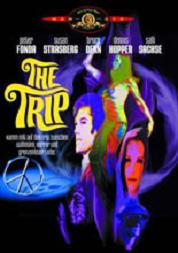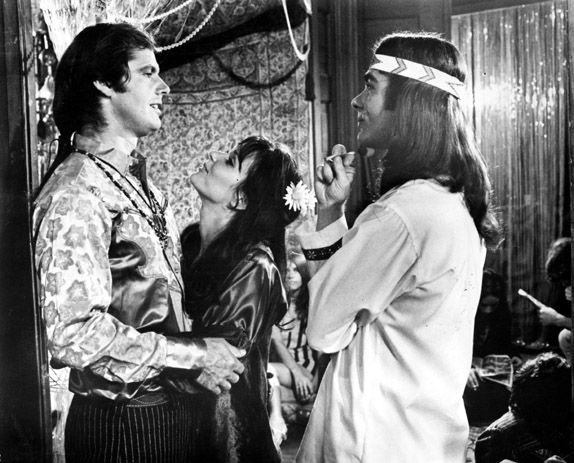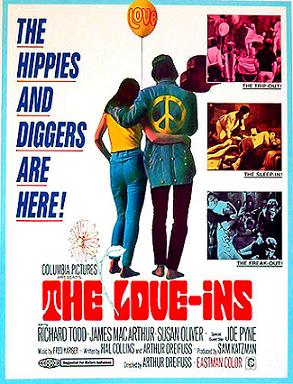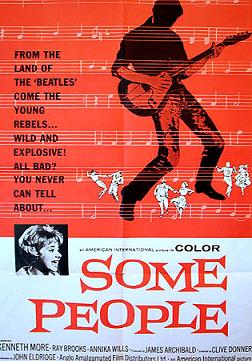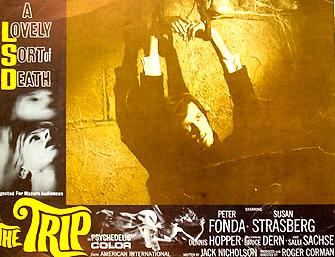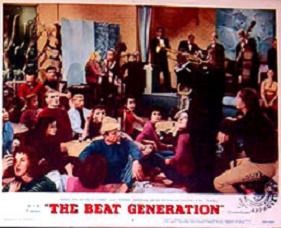 | The Trip (pr. Roger Corman), 1967 |
|
The Trip |
The Trip |
Nicholson, Strasberg and Stockwell in Psych-Out |
|
|
|
|
|
|
The trip - Roger Corman - 1967 |
|
Genre : Essai psychédélique
Réalisé par Roger Corman.
Avec Peter Fonda, Bruce Dern, Susan Strassberg, Dennis Hopper
After having wrung out the last likely broadcast of Italian gladiator flicks and fraying the sprockets on their Hammer Films collection, New Yorks ABC-TV affiliate, channel 7, slogged on to the next level upon acquiring a package of 60s psychedelic exploitation. It must have been around 1973 when I copped an overdose of these paisley parables, glorifications of hedonist trappings masquerading as cautionary public service announcements. Hollywood lies in the pursuit of realism, and through these films warned that drugs will indisputably lead one down the road to ruin. In the meantime, the gauzed lens fondled a pastel never-never land of some hitherto unknown utopia.
The Sixties didnt invent the drug film -- matinee idol Douglas Fairbanks played the teetering character, Coke Enneday, in the 1916 hallucinatory relic, The Mystery of the Leaping Fish -- but lifted it from stuffy 19th Century opium dens to jet-set candy-colored suburbia -- an environment Nick Ray tiptoed through in 1956, via James Masons cortisone addict of Bigger Than Life.
For a bored teen groping the tail end of that venerated era, what better way to kill a Saturday night than by watching Mimsy Farmer flip out on a bum acid trip in Riot on Sunset Strip? Better still, to be stoned doing it -- the next step in interactive television, requiring little more than a nickel bag of weed and a pack of rolling papers.
Historically sandwiched between Frankie Avalon hanging ten and Claudia Jennings knocking off backwoods filling stations, the drug movies were aesthetically stunted and anchored to their scene. Theres no mistaking, for example, George Montgomerys boo guru in The Hallucination Generation (1967), as anything but an icon in and of the tea-shade set. And this was a mere wavelet that blew through tinsel town, almost as quickly as the Summer of Love itself, leaving in its wake less than a handful of movies anyones bothered revisiting.
Of this bunch, The Trip (1967; photo at left) is a museum piece which observes a fidgety bourgeois (Peter Fonda) experiencing LSD for the first time. Producer/director Roger Corman tinkered with the free associations of Jack Nicholsons screenplay, building a sense of tension from the characters consuming shame (most of it sexual), and came up with a catalog of memorable moments. Confusion over everyday terminology (Fonda entering a living room: the LIVING room), wonderment over banality (his encounter with a washing machine), and fear of darkness and confinement (briefly imprisoned in a closet) are humorously accurate. His ultimate rendezvous with mystery woman Salli Sasche invites her hippie take on law enforcement: What police? There are no police! I dont believe in police! Made when even the lowly stag film boasted a level of modesty, The Trip touched on divorce and polygamy, culminating with a strobe-lit encounter between an apparently nude trio. What would be superfluous fodder on todays prime-time TV, it all caused something of a stir back in the day.
Less innovative but superlative nostalgia, Richard Rushs Psych-Out (1968) was partially filmed on location in San Franciscos Haight/Ashbury district during 1967s Summer of Love, and producer Dick Clark (yes) anted up the purple haze by gathering such flower-power ensembles as the Strawberry Alarm Clock and Sky Saxon with the Seeds for the soundtrack. In a screenplay by the one-shot-wonder team of E. Hunter Willett and Betty Ulius, its tale of a deaf runaway (Susan Strasberg) searching for her spiritually-confused brother (Bruce Dern) is chock-full of perceptive character silhouettes. From the coffee houses and galleries to crash pads and be-ins, we encounter the giggling burn-out (Max Julien proclaiming in the throes of lysergic rapture, Owsley is a saint!), the beads-and-sandals realist (the underrated Adam Roarke), the control-issued capitalist-in-denial (a pony-tailed Jack Nicholson as Stoney), the schizoid poster artist (Henry Jaglom, taking a circular saw to his wrist during a mental meltdown), and the cosmic intellectual (Dean Stockwell, one step ahead of the plastic hassle).
Although it pokes fun at outmoded racist attitudes (You sho do gots rhythm, Nicholson winks at Julien), Psych-Out is sexually archaic, confusing free love with the Playboy philosophy. Its female characters are intrusive, helpless mannequins when not lusted after by the Bizarro World Bowery Boys. So aggravated by their games, Strasberg downs an oversized batch of STP and blows her mind while standing alone in the middle of traffic on the Golden Gate Bridge -- a memorable slice of hippie noir.
The MGM Home Video brain trust has paired The Trip and Psych-Out on one DVD, complete with interviews (Corman, Rush, Lazslo Kovacs, Dern), trailers, and a Corman commentary for The Trip. Mostly for nostalgia do I consider Psych-Out something of a necessity. Ive fond memories of seeing it over twenty years ago in San Francisco at the Strand Theatre on Market Street, those effervescent Kovacs images in crisp 35mm on their palatial (albeit stained) screen.
While The Trip looks good on dvd (the sound is slightly low), Psych-Out was a shocking disappointment. The print transferred to dvd is not only scratched in the last reel, but its a cut version, reduced by some seven minutes. Among the missing: Max Juliens line about Owsley; the entirety of Strasbergs thrift store fashion show; and at least half of Pandoras (I.F. Jefferson) bead segment (a Kovacs hand-held tour-de-force) have been excised. One contemplated demanding a refund.
Luckily, I held on to my vhs copy of Psych-Out. It may not be widescreen, but it hasnt been trimmed by dullards, either.
Another films:
The Love-Ins (1967)
Window card: 14"x22"
D: Arthur Dreifuss
A: Richard Todd, Susan Oliver
"The hippies and diggers are here!"
Some People (1964)
One-sheet: 27"x41"
D: Clive Donner
A: Kenneth Moore
"From the land of The Beatles come the young rebels...wild and explosive!"
Youth gang becomes rock band.
The Beat Generation (1959)
Four lobby cards (#1, 2, 3, 4): 11"x14"
D: Charles Haas
A: Mamie Van Doren, Louis Armstrong
"Behind the weird ''way-out'' world of the beatniks!"
IMBd
Wiki about The Trip
Roger Cormen movies
psychévision
The Trip + Psych-Out

